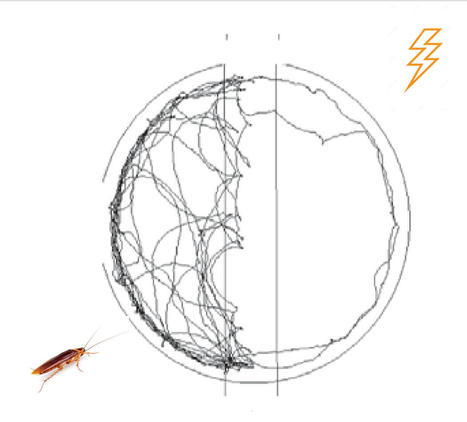"Static electric fields are common throughout the environment and this has been known for some time (e.g Lund (1929) and back in 1918, the great Jean-Henri Fabre, writing about the dung beetle, Geotrupes stated “They seem to be influenced above all by the electric tension of the atmosphere."
Shocking News – the truth about electroperception – insects can ‘feel’ electric fields | Don't Forget the Roundabouts
March 3, 2020 · 9:05 am
Traduction du début de l'article :
Les champs électrostatiques sont courants dans l'environnement, ce qui est connu depuis un certain temps (par exemple, Lund (1929) et, en 1918, le grand Jean-Henri Fabre, écrivant sur le bousier Geotrupes, déclarait : "Ils semblent être influencés avant tout par la tension électrique de l'atmosphère. Par les soirées chaudes et étouffantes, lorsqu'un orage se prépare, je les vois se déplacer encore plus que d'habitude. Le lendemain est toujours marqué par de violents coups de tonnerre".
Dans ces conditions, il est surprenant qu'il ait fallu attendre les années 1960 pour que les entomologistes commencent à s'intéresser réellement à l'électroperception, lorsqu'un entomologiste canadien décida d'approfondir le phénomène, mais en utilisant des mouches (Edwards, 1960). Il a constaté que si Drosophila melanogaster et Calliphora vicina étaient exposées à un champ électrique, mais pas en contact avec celui-ci, elles cessaient de se déplacer. Calliphora vicina avait besoin d'une tension plus forte pour provoquer une réponse que D. melanogaster, ce qui pourrait peut-être être lié à leurs tailles relatives. Il semblait que leur mouvement était réduit lorsque la charge électrique était appliquée et modifiée, mais pas si le champ était constant.
Traduit avec www.DeepL.com/Translator (version gratuite)
References
Bullock, T.H. (1999) The future of research on elctroreception and eclectrocommunication. Journal of Experimental Biology, 10, 1455-1458.
Carreck, N. (2014) Electromagnetic radiation and bees, again…, Bee World, 91, 101-102.
Clarke, D., Whitney, H., Sutton, G. & Robert, D. (2013) Detection and learning of floral electric fields by bumblebees. Science, 340, 66-69.
Eagleson, C. (1940) Fire ants causing damage to telephone equipment. Journal of Economic Entomology, 33, 700.
Edwards, D.K. (1960) Effects of artificially produced atmospheric electrical fields upon the activity of some adult Diptera. Canadian Journal of Zoology, 38, 899-912.
Edwards, D.K. (1961) Influence of electrical field on pupation and oviposition in Nepytia phantasmaria Stykr. (Lepidoptera: Geometridae). Nature, 191, 976.
Fabre, J.H. (1918) The Sacred Beetle and Others. Dodd Mead & Co., New York.
Favre, D. (2011) Mobile phone induced honeybee worker piping. Apidologie, 42, 270-279.
Greggers, U., Koch, G., Schmidt, V., Durr, A., Floriou-Servou, A., Piepenbrock, D., Gopfert, M.C. & Menzel, R. (2013) Reception and learning of electric fields in bees. Proceedings of the Royal Society B, 280, 20130528.
Jackson, C.W., Hunt, E., Sjarkh, S. & Newland, P.L. (20111) Static electric fields modify the locomotory behaviour of cockroaches. Journal of Experimental Biology, 214, 2020-2026.
Jolivet, P. (1986) Les fourmis et la Television. L’Entomologiste, 42,321-323.
Kim, K.H., Kabir, E. & Jahan, S.A. (2016) The use of cell phone and insight into its potential human health impacts. Environmental Monitoring & Assessment, 188, 221.
Lambinet, V., Hayden, M.E., Reigel, C. & Gries, G. (2017a) Honeybees possess a polarity-sensitive magnetoreceptor. Journal of Comparative Physiology A, 203, 1029-1036.
Lambinet V, Hayden ME, Reigl K, Gomis S, Gries G. (2017b) Linking magnetite in the abdomen of honey bees to a magnetoreceptive function. Proceedings of the Royal Society, B., 284, 20162873.
Lazáro, A., Chroni, A., Tscheulin, T., Devalez, J., Matsoukas, C. & Petanidou, T. (2016) Electromagnetic radiation of mobile telecommunication antennas affects the abundance and composition of wild pollinators. Journal of Insect Conservation, 20, 315-324.
Little, E.C. (1984) Ants in electric switches. New Zealand Entomologist, 8, 47.
Lund, E.J. (1929) Electrical polarity in the Douglas Fir. Publication of the Puget Sound Biological Station University of Washington, 7, 1-28.
MacKay, W.P., Majdi, S., Irving, J., Vinson, S.B. & Messer, C. (1992) Attraction of ants (Hymenoptera: Formicidae) to electric fields. Journal of the Kansas Entomological Society, 65, 39-43.
Maw, M.G. (1961) Behaviour of an insect on an electrically charged surface. Canadian Entomologist, 93, 391-393.
Mialon, H.M. & Nesson, E.T. (2020) The association between mobile phones and the risk of brain cancer mortality: a 25‐year cross‐country analysis. Contemporary Economic Policy, 38, 258-269.
Mouritsen, H., Heyers, D. & Güntürkün, O. (2016) The neural basis of long-distance navigation in birds. Annual Review of Physiology, 78, 33-154.
Odemer, R., & Odemer, F. (2019). Effects of radiofrequency electromagnetic radiation (RF-EMF) on honey bee queen development and mating success. Science of The Total Environment, 661, 553–562.
Perumpral, J.V., Earp, U.F. & Stanley, J.M. (1978) Effects of electrostatic field on locational preference of house flies and flight activities of cabbage loopers. Environmental Entomology, 7, 482-486.
Sharma, V.P. & Kumar, N.R. (2010) Changes in honeybee behaviour and biology under the influence of cellphone radiation. Current Science, 98, 1376-1378.
Simkó, M. & Mattson, M.O. (2019) 5G wireless communication and health effects—A pragmatic review based on available studies regarding 6 to 100 GHz. International Journal of Environmental Research & Public Health, 16, 3406.
Vanbergen, A.J., Potts, S.G., Vian, A., Malkemper, E.P., Young, J. & Tscheulin, T. (2019) Risk to pollinators from anthropogenic electro-magnetic radiation (EMR): Evidence and knowledge gaps. Science of the Total Environment, 695, 133833.
Wijenberg, R., Hayden, M.E., Takáca, S. & Gries, G. (2013) Behavioural responses of diverse insect groups to electric stimuli. Entomoloogia experimentalis et applicata, 147, 132-140.



 Your new post is loading...
Your new post is loading...







